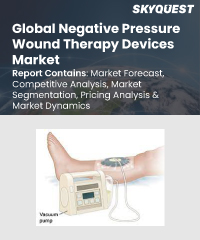
Report ID: SQMIG35A2463

Report ID:
SQMIG35A2463 |
Region:
Global |
Published Date: March, 2024
Pages:
219
|
Tables:
91 |
Figures:
76
Negative Pressure Wound Therapy Devices Market Drivers
Increasing Chronic Wounds and Surgical Procedures
Advancements in NPWT Technology
Favorable Reimbursement Policies
Negative Pressure Wound Therapy Devices Market Restraints
Complexity and Training
Risk of Complications
High Costs
Our industry expert will work with you to provide you with customized data in a short amount of time.
REQUEST FREE CUSTOMIZATIONWant to customize this report? This report can be personalized according to your needs. Our analysts and industry experts will work directly with you to understand your requirements and provide you with customized data in a short amount of time. We offer $1000 worth of FREE customization at the time of purchase.

Report ID: SQMIG35A2463